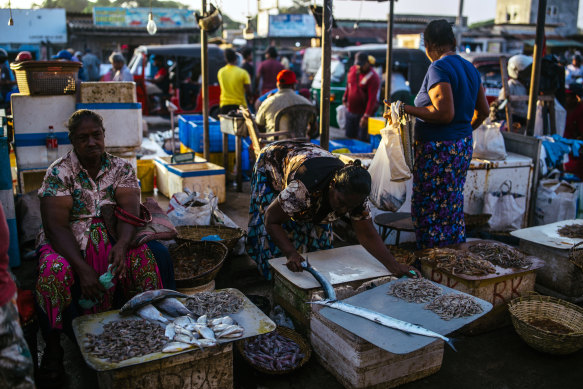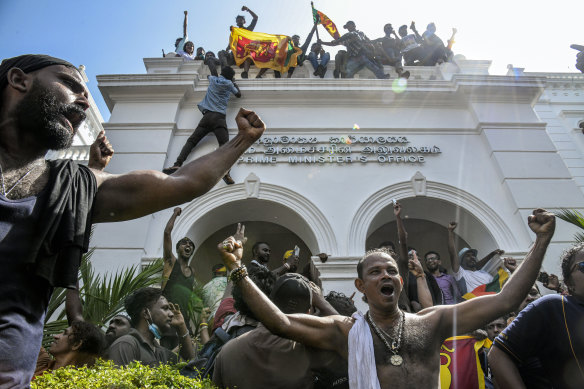
For decades, temporary covers – from majoritarian ethnic nationalism to the economic boost from heavy spending at the end of the civil war – papered over anger at “the decadence of this political elite,” said Nirmal Dewasiri, a professor of history at the University of Colombo, in Sri Lanka’s capital.
The economic collapse two years ago, Dewasiri added, awakened the country to how deep and structural the political rot was.

Breaking the mould: Commanders of the security forces stand behind as Sri Lanka’s new president Anura Kumara Dissanayake, addresses a gathering after he was sworn in at the Sri Lankan President’s Office.Credit: AP
Now, with Dissanayake’s victory, “it’s a very unique situation,” Dewasiri said. The two traditional political camps “have sort of broken down”.
Power long alternated between two dominant parties until one of them, the centre-right United National Party, entrenched itself in the 1970s and ruled for 17 years.
The party’s consolidation of power and crackdown on dissenting voices helped lead to violent insurrections – the three-decade Tamil insurgency in the north, and repeated violent Communist insurrections in the south. New coalitions and networks formed to topple the UNP.
Another reality was also emerging. While established politics long relied on rural patronage, the country was developing a new urban and semi-urban middle class that was looking beyond party structures for a path to prosperity.

Negombo’s fish market on Sri Lanka’s west coast. The country’s economy continues to suffer from deep structural flaws.Credit: Kang-Chun Cheng/The New York Times
The Rajapaksa family stepped into this moment of churn, tapping into the nationalism of the majority Buddhist Sinhalese population to rule for 10 years under its patriarch, Mahinda Rajapaksa. When his tenure ran its course, a second Rajapaksa brother, Gotabaya, ascended to power in 2019 with a campaign intended to appeal to the urban middle class.
He pitched himself as a technocratic “nonpolitician” who was at once an insider and an outsider, a former army officer who was returning from living in the United States. As a candidate he held a series of symposiums around the country where professionals would offer solutions to problems.
But the economic crisis and the resulting protests that forced out Rajapaksa provided an opening for other political forces that had spent years organising.
“Many of the things that we would have been speaking about in the past I think began to make sense to people – that, primarily, the problem in the country stems from the political culture, corruption, nepotism, the patronage system,” Harini Amarasuriya, an academic and activist who is a senior leader of Dissanayake’s alliance, said in an interview before the vote.
On Tuesday, Amarasuriya was appointed as the new prime minister. While she is the third woman to hold the post, women’s representation in parliament still remains just 5 per cent. The two previous women prime ministers both came from a political dynasty.

Protesters celebrate after taking control of the prime minister’s office in Colombo, Sri Lanka, in July 2022. A wave of discontent crested that year with a popular uprising over an economic collapse.Credit: Atul Loke/The New York Times
Janatha Vimukthi Peramuna, the Marxist party that Dissanayake helped lead to power as part of a broader coalition, is drastically different today than when he joined it as a student leader in the 1980s.
Thousands were killed in violence between JVP insurgents and Sri Lankan government forces. Dissanayake’s own family home was burnt, and the family was forced to live in a relative’s kitchen. A cousin his parents had raised almost as a sibling to Dissanayake was shot dead not far from him. He kept this news from his family for a decade, he said; they kept a vigil and visited temples to pray for his return.
In Sinhalese Buddhist culture, families keep a horoscope that, based on planetary alignments, predicts their child’s future. Past leaders, particularly the Rajapaksas, emphasised astrology in political life. When Dissanayake was asked in a recent interview whether his horoscope had predicted his rise, he was blunt.
“In 1989, our house was burnt. My horoscope got burnt with it, and I haven’t made a new horoscope since then. I don’t believe in horoscopes,” he said. “My parents didn’t have big dreams – their world wasn’t that big. The biggest hope my mother had for me was the teaching profession. That was their world.”
Loading
The JVP spent decades trying to distance itself from the violence and radical communism of its past. With the stigma not yet fully gone, Dissanayake ran under the name of his coalition, the National People’s Power. Though the coalition retained the JVP at its core, it brought in academics and activists like Amarasuriya who had none of the old political baggage and could better articulate an alternative vision.
The alliance vowed to change the political culture within existing frameworks. It reached out to young people and women who had long been on the political margins. It ensured “a feminist sensitivity” by putting female voices in its leadership and mobilising women voters, Amarasuriya said.
Two years before, it had been young people and women who spilled into the streets as the economy cratered.
“Although the husband might bring the money, the women felt the brunt more because they run the kitchen,” said Hiranthi Boralessa, 59, a teacher in the southern district of Galle.
Loading
She had been married to a JVP leader for over three decades but had only now gotten directly involved in political organising.
Her husband, Dharmawardhana Munasinghe, 69, a retired teacher, was part of the earliest leadership of the JVP. His detention at an army camp, and his cat-and-mouse game with authorities for nearly a decade after, complicated their young romance. Their wedding had to wait for a decade, and it eventually happened at a small, hushed ceremony in Colombo.
Munasinghe said that in all the decades after the party distanced itself from the violence, it had remained a marginal player in Galle. But he said the landscape changed entirely after the 2022 protest movement, with the local cells of the two main parties discredited over the economic collapse and hated for years of impunity for local abuses.
He said that Dissanayake’s pragmatism and discipline had achieved what older generations of leftist leaders could not.
“I’m not a wizard or a magician – I am a normal citizen of this country,” Dissanayake said after taking the oath of office in a low-key ceremony in Colombo on Monday “My main task now is to absorb my skills and collect my knowledge to lead this country. It is my responsibility to be a part of that collective intervention.”
This article originally appeared in The New York Times.









 Add Category
Add Category